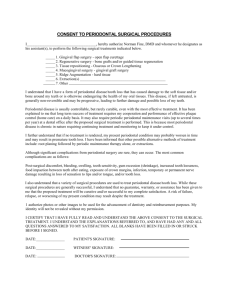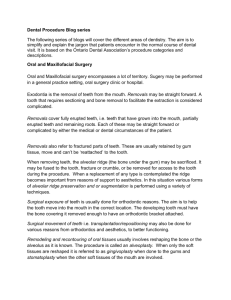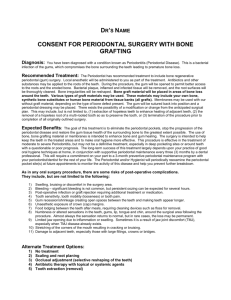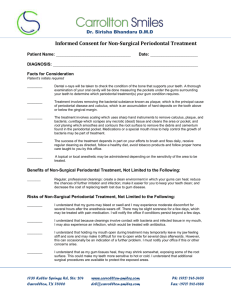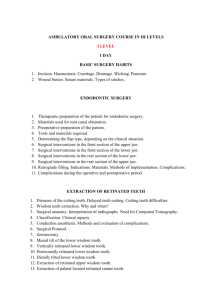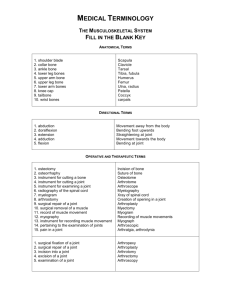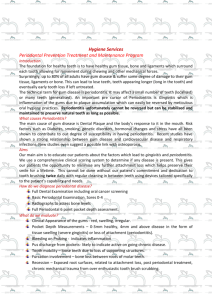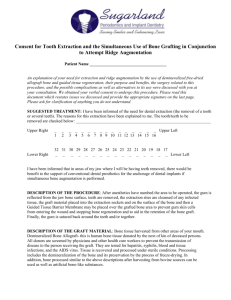CONSENT TO PERIODONTAL SURGERY
advertisement
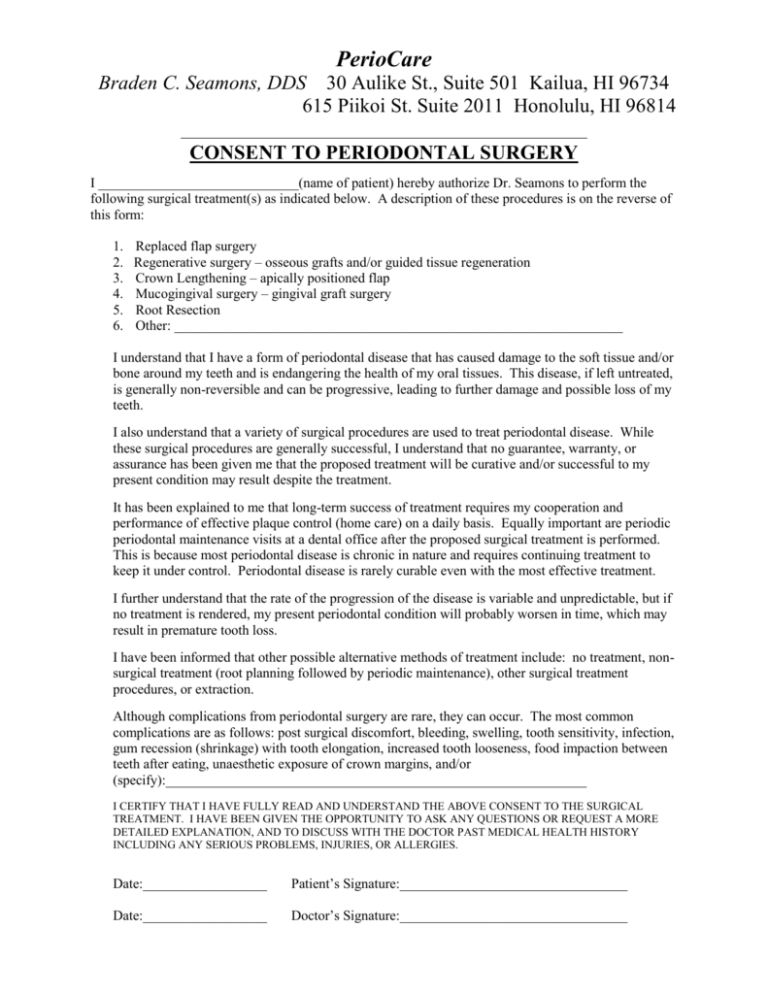
PerioCare Braden C. Seamons, DDS 30 Aulike St., Suite 501 Kailua, HI 96734 615 Piikoi St. Suite 2011 Honolulu, HI 96814 CONSENT TO PERIODONTAL SURGERY I _____________________________(name of patient) hereby authorize Dr. Seamons to perform the following surgical treatment(s) as indicated below. A description of these procedures is on the reverse of this form: 1. 2. 3. 4. 5. 6. Replaced flap surgery Regenerative surgery – osseous grafts and/or guided tissue regeneration Crown Lengthening – apically positioned flap Mucogingival surgery – gingival graft surgery Root Resection Other: _________________________________________________________________ I understand that I have a form of periodontal disease that has caused damage to the soft tissue and/or bone around my teeth and is endangering the health of my oral tissues. This disease, if left untreated, is generally non-reversible and can be progressive, leading to further damage and possible loss of my teeth. I also understand that a variety of surgical procedures are used to treat periodontal disease. While these surgical procedures are generally successful, I understand that no guarantee, warranty, or assurance has been given me that the proposed treatment will be curative and/or successful to my present condition may result despite the treatment. It has been explained to me that long-term success of treatment requires my cooperation and performance of effective plaque control (home care) on a daily basis. Equally important are periodic periodontal maintenance visits at a dental office after the proposed surgical treatment is performed. This is because most periodontal disease is chronic in nature and requires continuing treatment to keep it under control. Periodontal disease is rarely curable even with the most effective treatment. I further understand that the rate of the progression of the disease is variable and unpredictable, but if no treatment is rendered, my present periodontal condition will probably worsen in time, which may result in premature tooth loss. I have been informed that other possible alternative methods of treatment include: no treatment, nonsurgical treatment (root planning followed by periodic maintenance), other surgical treatment procedures, or extraction. Although complications from periodontal surgery are rare, they can occur. The most common complications are as follows: post surgical discomfort, bleeding, swelling, tooth sensitivity, infection, gum recession (shrinkage) with tooth elongation, increased tooth looseness, food impaction between teeth after eating, unaesthetic exposure of crown margins, and/or (specify):_____________________________________________________________ I CERTIFY THAT I HAVE FULLY READ AND UNDERSTAND THE ABOVE CONSENT TO THE SURGICAL TREATMENT. I HAVE BEEN GIVEN THE OPPORTUNITY TO ASK ANY QUESTIONS OR REQUEST A MORE DETAILED EXPLANATION, AND TO DISCUSS WITH THE DOCTOR PAST MEDICAL HEALTH HISTORY INCLUDING ANY SERIOUS PROBLEMS, INJURIES, OR ALLERGIES. Date:__________________ Patient’s Signature:_________________________________ Date:__________________ Doctor’s Signature:_________________________________ 1. REPLACED FLAP THERAPY – Under local anesthesia, the gum tissue is surgically detached from the teeth and gently retracted to expose the roots. After thoroughly cleaning the root surfaces, tissue is secured back in place with sutures. Sometimes smoothing or re-contouring the underlying bone is necessary. 2. REGENERATIVE THERAPY – This is a variable of the procedure. In addition to thoroughly cleaning the root surfaces, various materials may be placed under the tissue in an attempt to regenerate the connective tissue and/or bone previously destroyed by the disease process. These materials do not guarantee the regeneration of the lost support, but have been demonstrated to be more effective than replaced flap therapy. The following materials are commonly employed: A) Bone particles obtained by the re-contouring process above are placed into the bony defect to stimulate growth. B) Inert, man-made “bone crystals”, composed of the same minerals as in natural bone, are used to fill the bony defects. C) Membranes of Teflon or other substances are placed between the gum tissue and the bone and secured in place with sutures. These aid the repair process by preventing the soft gum tissue from interfering with new bone formation during the early stages of the healing period. A second surgical phase may be required to remove the membrane after a suitable healing period. D) One of the most common tissues used today in regenerative techniques is decalcified freeze-dried bone. This material is taken under sterile conditions from donors with no known systemic disease, and blood tests are negative for any infection. The tissue is also tested (cultured), then decalcified and processed under strict laboratory conditions known to kill all bacteria and viruses under experimental conditions. It is then cultured again for any contamination, and stored in a vacuum-sealed sterile container until it is ready to be opened during the surgical procedure. 3. CROWN LENGTHENING – The gingival margin (gumline) is altered to expose more of the tooth. This may be desirable to decrease the pocket depth around the teeth, to improve cleansability, or to allow the restorative to restore a badly broken down tooth. This procedure often requires removal of some of the bone around the necks of the teeth. 4. MUCOGINGIVAL SURGERY – Gum tissue may be moved or transplanted from one area of the mouth to another in an attempt to reinforce the gumline or to cover an area of exposed root surface. If the roof of the mouth is used as the donor site, a protective plastic liner may be placed to protect that area while it is healing. 5. ROOT RESECTION – In some cases, only one root of a multi-rooted tooth is affected. Rather than remove the entire tooth, the infected root can be removed using surgical procedures described above (replaced flap/crown lengthening). Sometimes a portion of the crown is removed at the same time. 6. OTHER -
